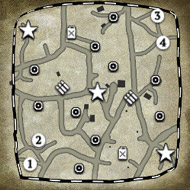The problem with my inital question is, that from the 38 divisions the Waffen SS had, about 28 were involved at the eastern front, but not all the time. Some were withdrawn to other theatres or refit to Germany. I estimate that from all axis forces at the eastern front about 10-15% were waffen SS later in the war. You think this guess is about correct?
Yea, as mentioned very vague and general question which would get an equal response. Throughout the latter years of the war a division on paper, could be just a couple companies in reality, and many "divisions" were never fully mobilized or filled to begin with. You know the lore of Hitler ordering around vast armies on maps who were nothing but empty vessels in reality.
Also, to answer earlier disputes on whether or not the SS was actually given the best of the best, or meant to be elite, the clear answer is yes, and no. Some "elite" SS units were given the best tanks, but thier heer counterparts also got them, it's not as if say, the SS got Tigers and Panthers, and everyone else made do with Panzer 4s and StuGs...ironically often the exact opposite occurred even with "honortitled" SS divisions.
The equipment issue is one that goes both ways, for a bulk of the war even the most "elite" SS units had to beg, borrow, capture and steal to get much needed equipment. Panzer losses in even some of the most notable units were often replaced by StuGs and P4s as opposed to original Panther losses, for example, and one noted division, the 17th SS, with "elite" Panzer Grenadier designation with honor title, had no tanks at all for over a year, and a couple of it's motorized infantry battalions only had bicycles...and even when somewhat properly outfitted to defend france it was almost entirely StuGs outfitting it's "panzer" battalion, let alone the assault gun battalion...it never had more than literally one or two actual Panzers which irrc were "command" tanks.
So much for getting the best equipment and tanks...and this unit was expected to be one of the cornerstones for pushing the allies back into the sea and is famous for it's fierce fighting in St.Lo, Carantan, and throughout France until it was completely destroyed...and that's just one of several examples.
In reality, the SS indeed had to scrounge around for equipment, and the fact that the SS were issued camouflage uniforms decades ahead of their time is not really evidence of being "elite" either, people forget the regular heer and luftwaffe ground forces were also given rather good camouflage uniforms, for some units in exceptional numbers as well. And of course the 12th SS, 1st SS, and even the luftwaffe "requisitioned" a lot of their camo from italian sources...
In theory, one reasons I consider most SS combat divisions "elite" is simple, actual combat record, the morale and fighting spirit generally found in the SS, and the expectations that were demanded from them. Never underestimate unit morale being a big determining factor of actual combat ability. They all received the same training as their heer counterparts, but the fighting spirit of their volunteer force filled with propaganda about being superhhuman fighting machines actually made them so, in part at least. But, as I stated before, I will state again, many Heer units were just as tough, and just as "elite".
One simple test everyone can do, if you have a grandpa that fought the nazis, ask them what they think about the Waffen SS in general as combat soldiers, irregardless of their criminal actions. The answer won't suprise anyone...













 Frontline Emergency Troops or Quick Reaction Force might be closer to the actual meaning
Frontline Emergency Troops or Quick Reaction Force might be closer to the actual meaning 








 cblanco ★
cblanco ★  보드카 중대
보드카 중대  VonManteuffel
VonManteuffel  Heartless Jäger
Heartless Jäger 